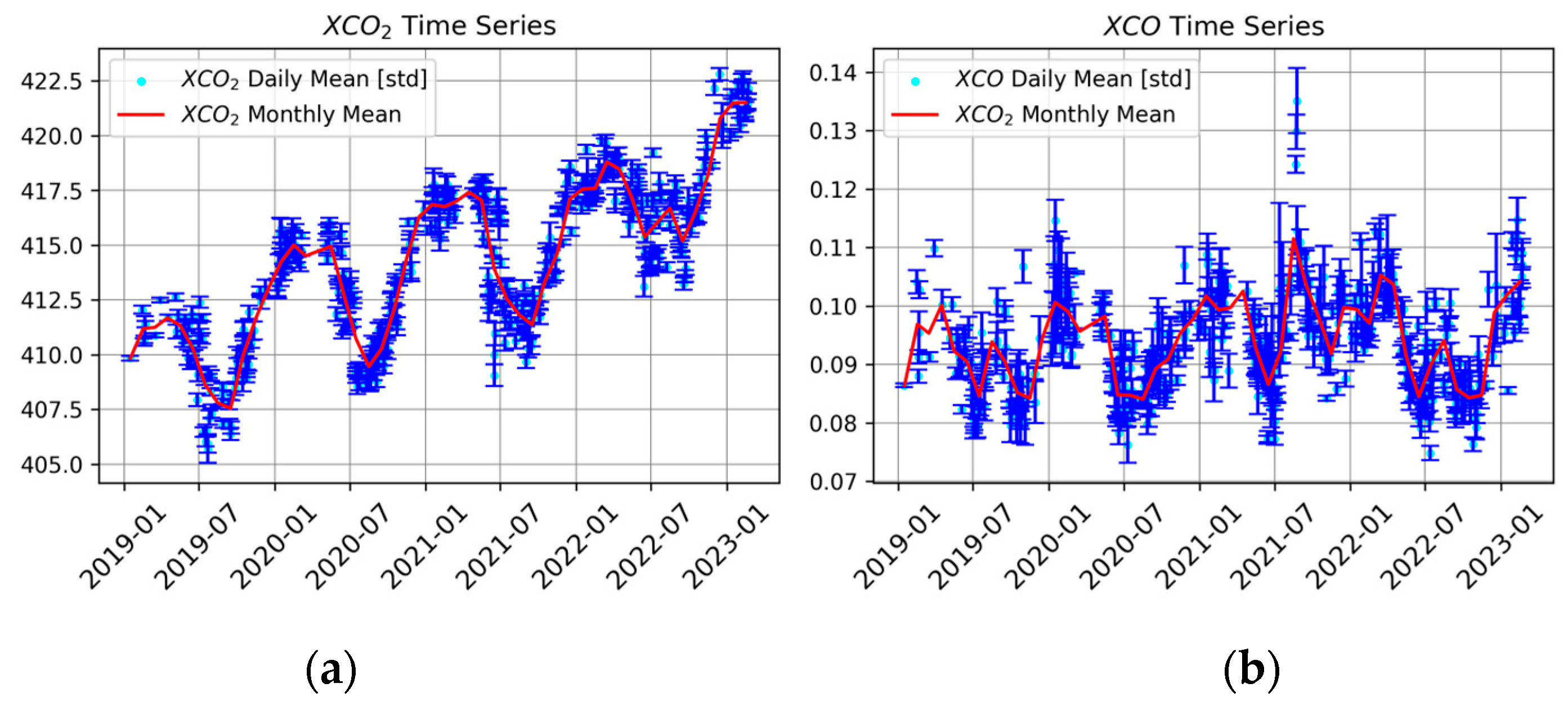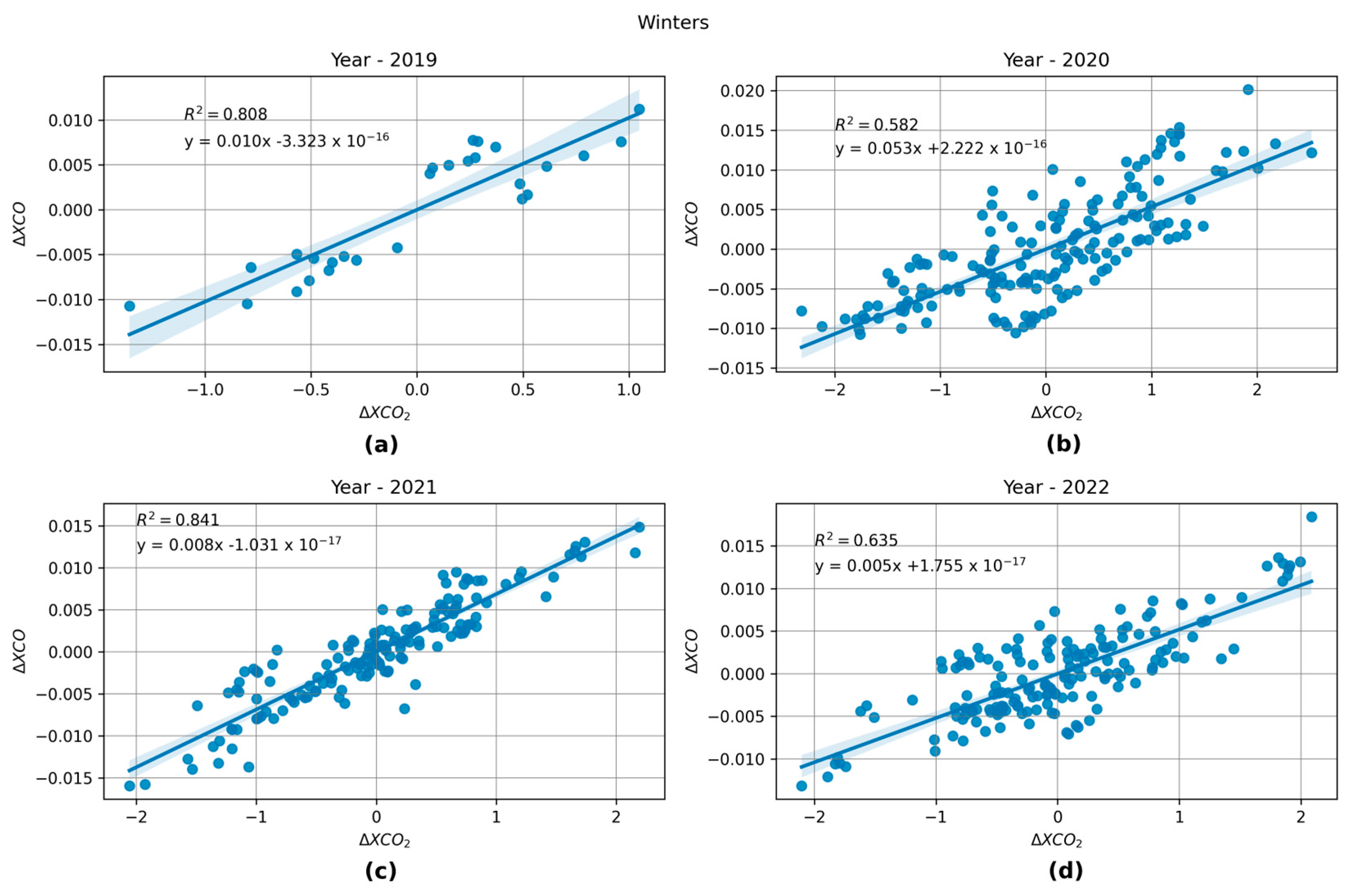Analyzing Four Years of Ground-Based Measurements of XCO2 and XCO over Thessaloniki, Greece Using FTIR Spectroscopy †
Abstract
:1. Introduction
2. Methodology
3. Results
Carbon Monoxide and Carbon Dioxide Co-Variability
4. Conclusions
- The time series for XCO2 demonstrates the emergence of the seasonal cycle, with maxima occurring in winter and spring due to anthropogenic influence and a summer minimum resulting from the biosphere cycle, which is a local phenomenon for mid-latitude regions of the Northern Hemisphere. The time series for exhibits a greater variability in its daily values due to local sources, with a maximum occurring in winter and a minimum in summer , reflecting the common sources shared with carbon dioxide. However, the concentration of carbon monoxide can sometimes reach high levels during the summer months due to fires occurring in those periods, as was the case in July 2021 when the concentration was measured at 0.141 ± 0.013 ppm.
- The study of the co-variability of ΔXCO and ΔXCO2 residuals throughout the seasonal cycle showed good agreement for the winter months ( and a significant correlation coefficient in spring. These findings suggest that there are strong influences of fossil fuel as a common emission source for the two gases during these seasons. However, in the summer and autumn months, the two gases are not correlated due to the higher seasonality of XCO2 compared to XCO, indicating that the emission sources for these two gases differ during these seasons. Therefore, it is crucial to consider the seasonal variability of the sources when studying atmospheric chemistry and air pollution.
Author Contributions
Funding
Data Availability Statement
Acknowledgments
Conflicts of Interest
References
- Duxbury, J.M. The Significance of Agricultural Sources of Greenhouse Gases. Fertil. Res. 1994, 38, 151–163. [Google Scholar] [CrossRef]
- Barnosky, A.D.; Matzke, N.; Tomiya, S.; Wogan, G.O.U.; Swartz, B.; Quental, T.B.; Marshall, C.; McGuire, J.L.; Lindsey, E.L.; Maguire, K.C.; et al. Has the Earth’s Sixth Mass Extinction Already Arrived? Nature 2011, 471, 51–57. [Google Scholar] [CrossRef] [PubMed]
- AR5 Climate Change 2014: Mitigation of Climate Change—IPCC. Available online: https://www.ipcc.ch/report/ar5/wg3/ (accessed on 8 May 2023).
- Röckmann, T.; Brenninkmeijer, C.A.M.; Saueressig, G.; Bergamaschi, P.; Crowley, J.N.; Fischer, H.; Crutzen, P.J. Mass-Independent Oxygen Isotope Fractionation in Atmospheric CO as a Result of the Reaction CO + OH. Science 1998, 281, 544–546. [Google Scholar] [CrossRef] [PubMed]
- Wunch, D.; Toon, G.C.; Blavier, J.F.L.; Washenfelder, R.A.; Notholt, J.; Connor, B.J.; Griffith, D.W.T.; Sherlock, V.; Wennberg, P.O. The Total Carbon Column Observing Network. Philos. Trans. R. Soc. A Math. Phys. Eng. Sci. 2011, 369, 2087–2112. [Google Scholar] [CrossRef] [PubMed]
- Gisi, M.; Hase, F.; Dohe, S.; Blumenstock, T.; Simon, A.; Keens, A. XCO2-Measurements with a Tabletop FTS Using Solar Absorption Spectroscopy. Atmos. Meas. Tech. 2012, 5, 2969–2980. [Google Scholar] [CrossRef]


| 2019 | 2020 | 2021 | 2022 | |
|---|---|---|---|---|
| 409.59 ± 1.93 | 412.41 ± 2.29 | 414.65 ± 2.53 | 416.97 ± 1.73 | |
| 0.088 ± 0.007 | 0.091 ± 0.008 | 0.097 ± 0.009 | 0.092 ± 0.008 |
Disclaimer/Publisher’s Note: The statements, opinions and data contained in all publications are solely those of the individual author(s) and contributor(s) and not of MDPI and/or the editor(s). MDPI and/or the editor(s) disclaim responsibility for any injury to people or property resulting from any ideas, methods, instructions or products referred to in the content. |
© 2023 by the authors. Licensee MDPI, Basel, Switzerland. This article is an open access article distributed under the terms and conditions of the Creative Commons Attribution (CC BY) license (https://creativecommons.org/licenses/by/4.0/).
Share and Cite
Panou, T.; Topaloglou, C.; Mermigkas, M.; Balis, D.; Dubravica, D.; Hase, F. Analyzing Four Years of Ground-Based Measurements of XCO2 and XCO over Thessaloniki, Greece Using FTIR Spectroscopy. Environ. Sci. Proc. 2023, 26, 52. https://doi.org/10.3390/environsciproc2023026052
Panou T, Topaloglou C, Mermigkas M, Balis D, Dubravica D, Hase F. Analyzing Four Years of Ground-Based Measurements of XCO2 and XCO over Thessaloniki, Greece Using FTIR Spectroscopy. Environmental Sciences Proceedings. 2023; 26(1):52. https://doi.org/10.3390/environsciproc2023026052
Chicago/Turabian StylePanou, Thomas, Chrysanthi Topaloglou, Marios Mermigkas, Dimitrios Balis, Darko Dubravica, and Frank Hase. 2023. "Analyzing Four Years of Ground-Based Measurements of XCO2 and XCO over Thessaloniki, Greece Using FTIR Spectroscopy" Environmental Sciences Proceedings 26, no. 1: 52. https://doi.org/10.3390/environsciproc2023026052
APA StylePanou, T., Topaloglou, C., Mermigkas, M., Balis, D., Dubravica, D., & Hase, F. (2023). Analyzing Four Years of Ground-Based Measurements of XCO2 and XCO over Thessaloniki, Greece Using FTIR Spectroscopy. Environmental Sciences Proceedings, 26(1), 52. https://doi.org/10.3390/environsciproc2023026052






